Isolepis
Isolepis R.Br.
Family: Cyperaceae
Common names: Sedges (Eng); madzhesi (Tshivenda)
Introduction
The genus Isolepis R.Br. comprises about 76 species. Members in the genus Isolepis mostly occur in the temperate regions of the southern hemisphere. Isolepis has its highest diversity in the winter rainfall area of southern Africa where species with annual life forms occur in ephemeral wetlands (obligate aquatics), whereas, perennial species frequently form mats at the edges of wetlands (facultative aquatics) or float in shallow fresh water.

Description
Description
The underground system of Isolepis consists of minute roots or rhizomes. Species with these kinds of roots grow in tufts with up to 50 culms, each tuft with one or more internodes which may be very short so that the leaves are set basally, consisting of only an elongated peduncle.

Some taxa , e.g. I. setacea (L.) R.Br. and I. cernua (Vahl) Roem. & Schult. var. andina Muasya that grow within the alpine zone of tropical mountains, have a tufted habit at lower altitudes, but become increasingly mat-forming as altitude increases. Other species have a horizontal, whitish to yellowish rhizome up to 20mm long. Above ground rhizomes (runners) are found in the mat-forming species e.g. I. fluitans and allied taxa.
Some species have one to four elongated internodes, with a leaf at each node. The elongation of the basal internodes appears to be influenced by growing conditions. The leaves comprise a closed tubular sheath and a flat blade with the leaf sheath colour varying from green to purple-brown and usually shorter than the peduncle, except in high-altitude taxa such as the East African I. graminoides where the sheath partially covers the spikelet. The leaf blade is green and as long as the peduncle or reduced to a minute lobe.

In Isolepis the inflorescence consists of 1 to many spikelets. The spikelet morphology has been used to separate Isolepis and Ficinia from Cyperus which has flattened spikelets with distichous arranged glumes. Mostly Isolepis has terete spikelets with a spiral glume arrangement, but there are some Cape annual species which were previously described as Cyperus, before being transferred to Isolepis, based on a re-interpretation of morphology and evidence from the molecular phylogenetic data.

Conservation Status
Status
According to the 'Red list of South African Plants', most species of Isolepis were not screened as potential taxa of conservation concern and were given an automated status of LC (Least Concern). Some are known from a few localities and are stated as rare species, potentially threatened by alien plant invasion, e.g. Isolepis venustula Kunth , I . angelica B.L.Burtt , I. antarctica (L.) Roem. & Schult. and I. brevicaulis (Levyns) J.Raynal . Isolepis pellocolea B.L. Burtt is known from only three sites and is restricted to alpine bogs. It is potentially threatened by overgrazing in Lesotho. Isolepis inconspicua (Levyns) J. Raynal is known from old collections from the Cape Peninsula and was assumed to be extinct.
Since 2002, three new subpopulations have been discovered. One is in natural habitat (riverlands) but two are very isolated and in roadside depressions. The specialized habitat of I. venustula is being impacted by coastal development and alien plant invasion that causes the continuing decline of habitat quality and numbers of mature individuals.

Distribution and habitat
Distribution description
Isolepis is known to be widely distributed in temperate and alpine regions mainly in the southern hemisphere. Most members of Isolepis grow in eastern and southern Africa, Australia and New Zealand. Most of the species are represented in Africa, whereas few are found in Australasia and South America. The distribution ofIsolepis in Australasia and the Americas, is due to rare long-distance dispersal events followed by speciation in the new habitats. Subgenus Fluitantes is most widespread, represented in all continents except the Americas. Isolepis cernua is the most distantly spread species in the genus, growing in a wide range of habitats in temperate Africa, Australasia, Europe, North America and South America.
Derivation of name and historical aspects
History
The use of the genus name Isolepis (Cyperaceae) was confined to the nineteenth century. Robert Brown separated Isolepis from other genera in the tribe Scirpeae on the artificial basis perianth segments. This genus was readily accepted along with other natural genera of Brown, e.g. Eleocharis, by Roemer and Schultes, Nees, Kunth and others. The greatest recognition for the genus came with Steudel who listed 200 names, 70 of which were his own. Boeckeler finally decided that the genus was artificial and included all the Isolepis names known to him in other genera, mostly in Scirpus sensu lato. Most of the subsequent workers took the lead of Boeckeler, although a few writers continued to describe new names in Isolepis. At the turn of the century the genus was wholly discarded but by that time 470 synonyms had been made. The French botanist, Jean Raynal finally resurrected Isolepis in the late 1970s and it has generally been upheld since then. There has been much disagreement over the taxonomic position of Isolepis in the Cyperaceae. The genus has usually been placed with Scirpus in the tribe Scirpeae, based on the shared spirally arranged glumes.
Uses
Use
Several species have potential use as ornamentals. Most of the sedges act as water purification and erosion control agents and this makes them an important component of wetlands. Isolepis setacea (L.) R.Br. is recorded as a weed in wheat farms in Ethiopia.
Growing Isolepis
Grow
Species of Isolepis can be grown as house plants in sunny windows or greenhouses, in winter. They are generally propagated by dividing the overcrowded clumps. They should be kept in constantly moist soil. These plants grow actively all year long in temperatures above 13°C , however, they can tolerate lower temperatures. They can add a dimension to landscaping in gardens and provide attractive foliage around water features.

Species
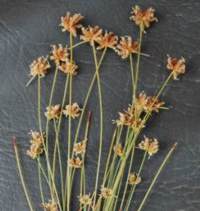
Isolepis antarctica (L.) Roem. & Schult.
Isolepis antarctica is an annual of about 80 to 200 mm tall, with numerous straw-coloured and dark red spikelets that consist of an indeterminate rachilla with many, spirally arranged glumes, with each glume subtending a bisexual flower. Its subtending glumes develop slowly and older glumes grow into a bonnet-like shape, protecting the fruit. It is widely distributed in damp flats and slopes up to 800 m altitude, from the Cape Peninsula to Langeberg Mountains in the Western Cape. It flowers between October to November.
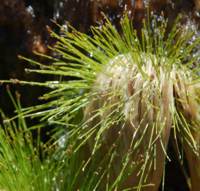
Isolepis digitata Schrad.
Isolepis digitata is a tufted perennial of about 150 to 200 mm tall, with green spikelets. It is commonly found attached to rocks in streams, below 1 000 m altitude, between Clanwilliam and Riversdale in the Western Cape. It flowers between September and January.
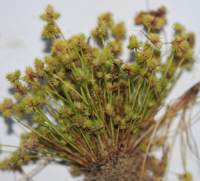
Isolepis hystrix (Thunb.) Nees
Isolepis hystrix is a small, densely tufted, annual species about 20 to 100 mm tall, with green spikelets. It is usually found in damp flats, and sometimes at altitudes of about 1 600 m. It is widely distributed from Namaqualand to the Cape Peninsula. This species flowers between August and November.
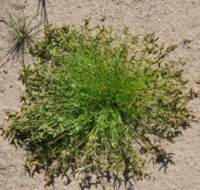
Isolepis levynsiana Muasya & D.A.Simpson
Isolepis levynsiana is a tufted annual up to 150 mm tall, with inflorescence and spikelets that are green or reddish, flattened with a distichous glume arrangement. It is widely distributed on lower mountain slopes, extending from Namaqualand in the Northern Cape to the Eastern Cape. Its flowers between September and January.
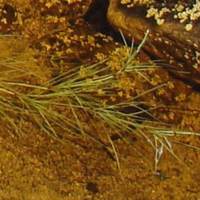
Isolepis striata (Nees) Kunth
Isolepis striata extends from Namaqualand to Riviersonderend to Uitenhage in the Eastern Cape, growing in pools at lower altitudes. It is a branched aquatic perennial with green or reddish terminal spikelets and glumes from 3.5 to 4.5 mm long. There are three involucral bracts that are shorter than the spikelets. The species flowers between August and December.
References
- Archer, C. 2000. Cyperaceae. In P. Goldblatt & J. Manning, (eds.), Cape plants. A conspectus of the Cape Flora of South Africa. Strelitzia 9: 81- 92.
- Archer, C. 1998. A new combination in Isolepis . Bothalia 28: 41, 42.
- Goetghebeur, P. 1998. Cyperaceae. In K. Kubitzki (ed.). The families and genera of vascular plants 4: 141 - 190. Springer, Berlin.
- Muasya, A.M. & Simpson, D.A. 2002. A monograph of the genus Isolepis R.Br. (Cyperaceae). Kew Bulletin 57: 257 - 362.
- Muasya, A.M., Simpson, D.A. & Smets, E. 2006. Isolepis tenella , a new combination in Cyperaceae. Novon 16(1): 89, 90.
- Muasya, A.M., Simpson, D.A. & Smets, E. 2007. Isolepis levynsiana , a new name for Cyperus tenellus (Cyperaceae). Novon 17(1): 59 - 59 .
Credits
Aluwani A Tshiila
KwaZulu-Natal Herbarium
September 2014
Plant Attributes:
Plant Type: Aquatic, Bi/Annual, Perennial
SA Distribution:
Soil type:
Flowering season:
PH:
Flower colour:
Aspect:
Gardening skill:
Special Features:
Horticultural zones






Rate this article
Article well written and informative
Rate this plant
Is this an interesting plant?
Login to add your Comment
Back to topNot registered yet? Click here to register.